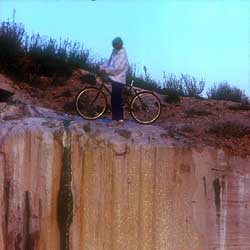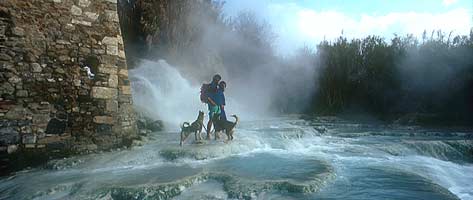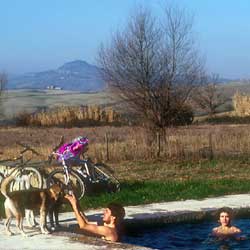|  History and legend, thermal springs and frozen mist, stupendous landscapes
and religious shrines, mountain goats and sulphur. A visit to the ancient
extinct volcano that is Mount Amiata offers the visitor unforgettable
experiences. And the most unusual of all is the pleasure of immersing
yourself in water smelling of sulphur that enfolds your body in a warm
caress, at Saturnia, Bagno Vignoni or Bagni San Filippo.
History and legend, thermal springs and frozen mist, stupendous landscapes
and religious shrines, mountain goats and sulphur. A visit to the ancient
extinct volcano that is Mount Amiata offers the visitor unforgettable
experiences. And the most unusual of all is the pleasure of immersing
yourself in water smelling of sulphur that enfolds your body in a warm
caress, at Saturnia, Bagno Vignoni or Bagni San Filippo.
Immersed in a natural bathtub made of creamy limestone, look above the
steam rising all around you at the imposing hulk of Mount Amiata, its
peaks dusted with white. With your body caressed and protected by the
hot water, feel the cool, fresh air on your cheeks.
Although this may seem the setting for an advertising spot it is instead
a reality ever visitor should experience. All you have to do is stop at
Bagni San Filippo, a little village known for its abundant hot springs
flowing out of the rock at a constant temperature of 37 degrees C, one
of the marvels of nature in the Monte Amiata area.
History and legend overlap at Mons Tunians, or Saturnia Tellus. The strategic
location of Monte Amiata, between Rome, Siena and Firenze, has drawn
to it for centuries personages, events and intrigues still perceptible
in the patterns of an architectural fabric often in architectural fabric
often intact: a land rich in villages that seem to grow out of bills eroded
by time where the meandering of white roads winding among little farms,
castles and forests comes to an end in sight of red-tiled roofs embellishing
Medieval towns or spas famous since antiquity.
Arriving from the north, the massive hulk of Monte Amiata with its unmistakable
profile shaped like the back of an enormous kneeling camel can be glimpsed
already from Siena. The cones of its two peaks betray its ancient volcanic
origin, bringing to mind eruptions, lava flows, explosions, and clouds
of volcanic dust, images of a spectacle that took place thousands of years
ago. With the passage of the centuries the volcanic activity has almost
ceased the lava has solidified and has been covered by a thick blanket
of vegetation. Here and there on the mountain, however, some white puffs
if steam still rise and the smell of sulphur pervades the air.

This is because the subsoil here is like a gigantic sponge that absorbs
enormous quantities of rainwater to redistribute it heated in a wide ring
of hot springs located at 600 to 900 meters of altitude. Amidst the thick
centuries-old forest of ash. In the chestnut woods and on the old lava
flows, the villages, towns and castles that have grown up over the centuries
are now fully equipped to welcome tourists making a visit to be entire
area not only extremely pleasant but also rich in historical and naturalistic
interest. As regards the latter, truly unforgettable is the rare phenomenon
of galaverna of frozen mist, a natural omen that occurs in autumn and
in spring sometimes breaking tree trunks and causing severe damage. But
more often these icy needles brought by the cold wind offer only moments
of unforgettable emotion to excursionist. And a ray of sunshine is enough
to make the galaverna vanish as if by magic, transformed into simple drops
of water.
 There
are many ways to discover Mount Amiata. One of the most interesting is
by train, arriving from Siena at Torrenieri and then continuing by bicycle.
Pedal through a week to discover an area of Italy pressing a very special
beauty of its own, not yet sufficiently appreciated which also offers
appointments with art and architectural history, such as the Portico of
St. Catherine of Siena surrounding the great 14th century pool at Bagno
Vignoni, the harmonious octagonal cistern of Rocca d’Orcia, the
16th century monastery of Piancastagnaio, and the Benedectine Abbey of
Abbadia S. Salvatore which dates back to the 8th century and is a rare
example of Germanic architecture in Italy. There
are many ways to discover Mount Amiata. One of the most interesting is
by train, arriving from Siena at Torrenieri and then continuing by bicycle.
Pedal through a week to discover an area of Italy pressing a very special
beauty of its own, not yet sufficiently appreciated which also offers
appointments with art and architectural history, such as the Portico of
St. Catherine of Siena surrounding the great 14th century pool at Bagno
Vignoni, the harmonious octagonal cistern of Rocca d’Orcia, the
16th century monastery of Piancastagnaio, and the Benedectine Abbey of
Abbadia S. Salvatore which dates back to the 8th century and is a rare
example of Germanic architecture in Italy.
These are the precious remains of a remote past, when Monte Amiata with
is silence and peace was dedicated above all to places of prayer and mediation
for important monastic orders. The mountain still conserves intact the
mysterious fascination of the Etruscans who first inhabited it and of
the Medieval travellers who passed through it by the thousand along the
Via Romea or Francigena, the roads taken by pilgrims. After having visited
Roccalbegna the itinerary makes a stop at the Etruscan-Roman walls of
Saturnia to find thermal springs again, hot water in which to relax and
feel rejuvenated. For the Romans it was Saturnia Tellus, where Saturn
father of the Goddess Juno and the God Jove, driven from his celestial
throne, found refuge, protected by the fumes of the abundant hot waters.
Even in the Middle Ages the Roman habit of frequenting public baths remained
in fashion here. In 1292 the magistrate of Siena concerned about the promiscuity
favoured by the baths issued an “ordinamentum balneorum” or
regulations to discipline the use of the baths which did not stop at verbal
prohibitions but even went so far as to erect partitions dividing the
bathers. Through this region passed the Via Francigena, one of the main
thoroughfares of the epoch for travellers who coming from the north and
passing through Siena were headed for Rome in Lombard territory. On their
way to the Holy City entire caravans stopped to rest in the area, using
the pools of Bagno Vignoni for hygienic and therapeutic purposes.
Pope Pius II writer and protector of artist, Lorenzo dé Medici
and St. Catherine of Siena came here to treat their illness with the waters
of the “thermae”. dell’epoca per chi dal nord attraversoAfter
a period when the custom of “passing the waters” feel into
disuse visitors in a recent years have flocked to the hot springs of Amiata
in search of the peace of other ages. From village along the rare paved
sections of the Medieval Via Francigena, to the visitor still experiences
the feeling of sinking into the folds of history : ready to meet at any
moment one of the figures from the past, a merchant a solder or a pilgrim.
|